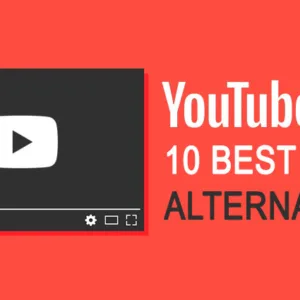There can’t be Netflix and chill without Netflix. Netflix redefined the way we watch video content. Without Netflix, the video content market may have been something else completely. It’s the place where you can stream the best TV shows, web series, movies, and other video content.
The success story of Netflix is fascinating because it includes a long road of trial and error, luck, and perfect timing.
In this article, we’ll cover all you want to know, including how and when Netflix started and its journey.
The Early Days of Netflix
Netflix originated in 1997 by Reed Hastings and Marc Randolph in a small Californian city called Scotts Valley in Santa Cruz County.
Reed Hastings said that the idea had sparked when I had gotten a fine of $40 for returning “Apollo 13” late. The sting of the fine inspired him to think up a service that allows people to order a movie online and get it by mail.
At first, Netflix was originally a rent-by-mail DVD service. And it used a pay-per-rental model as well.
People would order the movies they want to watch from the Netflix website, and then Netflix would post DVDs of movies to your door. After finishing the movie/show, the user would quickly post them back to Netflix.
The rental cost of a DVD was around $4 each and the posting charges for a DVD were $2. Soon thereafter, Netflix started a subscription-based service to rent DVDs.
Those who subscribed to the service could keep the DVDs for as long as they wanted. But, they could only order a new movie after returning previous DVDs.
The mail-order rental model of Netflix would directly challenge the brick-and-mortar giants like Blockbuster. In 2010, Blockbuster declared bankruptcy because it could not compete with the wave of online streaming and DVD rentals.
Blockbuster would have still been in service if they took Netflix up on their offer of a buy-out in 2000.
Presently, Netflix has a Market cap of around $209.74 billion. And it ranks as the world’s top streaming service.
Key Netflix Milestones
The history of Netflix is super fascinating. It’s a road full of ups and downs. Let’s go over some of the most important milestones in Netflix’s journey.
| Dates | Netflix Milestones |
| August 29, 1997 | – Netflix originated in Scotts Valley, California. – The founders decided to name the service Kibble during beta testing but later changed the name to Netflix. |
| April 14, 1998, | – Netflix launched its official website. – Its video library contained approximately 900 titles on the launch day. – Within 15 minutes, the website crashed due to a traffic surge. – On the first day itself, Netflix booked 137 orders. |
| 1999 | – Netflix subscribers had risen up to 239,000. – They expanded the video library to 3100 titles. – Reed becomes the CEO of Netflix. |
| 2000 | Netflix offered a $50 million deal to Blockbuster’s CEO John Antioco, but Blockbuster rejected the offer. |
| 2001 | Netflix crosses the one million subscribers milestone. |
| 2002 | – Netflix raises $82.1 million through IPO. – Netflix opens regional warehouses and starts offering overnight delivery service. |
| 2003 | March Randolph leaves Netflix and sells his shares. |
| 2006 | – Netflix becomes a profitable business and generates more than $80 million. – Monthly subscribers grow up to 6.3 million. |
| 2007 | – Netflix offers instant streaming option, allowing users to stream content directly to tablets, TVs, and computers. – Instant streaming service first became available in Canada with 1,000 titles. – Netflix offers a $5.99 per month DVD subscription tier for free. |
| 2010 | – Netflix changes its focus from DVD rental facilities to streaming facilities and started streaming facilities in the US. – DVD by mail service runs as it is. |
| 2011 | – Netflix starts two distinct packages for both the streaming business and DVD rental business. – Netflix takes over the streaming business. – After one month Reed reversed this decision because 8,00,000 people abandoned Netflix. |
| 2012 | – Netflix starts making original shows. – The first Netflix original was Lilyhammer. – After that, it produced over 1,900 originals till now. |
| 2013 | Netflix introduces user profiles. |
| 2015 | Netflix started offering its services in 50 countries. |
| 2016 | – Netflix started offering its live streaming in 130 countries. – Netflix adds local language to its interface. |
| 2017 | Netflix crossed 100 million subscribers. |
| 2021 | – Netflix crosses the 209 million subscribers milestone. – Netflix’s notable expectations are North Korea, China, Iran, and Syria. – Netflix contains 15,000 titles across all the international libraries. – Netflix hits $25 billion in annual revenues. – Netflix launched a mobile games service with a streaming service. |
Competition With Blockbuster
The primary competitor of Netflix was Blockbuster. The chief of retail video rental chain Blockbuster, Jhon Antioco, believed that people would prefer receiving copies in-store and watching immediately over waiting for days for the DVD in the mail.
At that time Netflix used US Postal Service to send DVDs to the customer. When Blockbuster’s new rental program came, Netflix was losing money, and thus, Reed Hastings met with John. Reed offered a 49% stake in Netflix to Blockbuster for just $50 million. Blockbuster chief John rejected this proposal.
Blockbuster had charged money as late fees, which was a significant part of its revenue. On the other hand, Netflix eliminated late fees and gave unlimited access to DVDs to its customers.
The two difficulties of Netflix were:
- Netflix took DVD orders online because it has a lack of stores.
- Netflix did not charge any late fees.
The fewer storage facilities and the elimination of late fees were two factors that decreased the revenue of Netflix. On the other hand, Blockbuster charged late fees, and it had many offline stores.
After that, Netflix offered their IPO on March 24, 2002, and subscribed with $82.5 million. At that time company was making a loss of $4 million on $30.5 million of revenue.
In 2004, Blockbuster started an online DVD rental space and also eliminated late fee charges. These two changes increased costs and reduced the profits of Blockbuster. Blockbuster’s online initiative lost momentum, and thus, it reintroduced late fees as well.
80% of the shares of Blockbuster were held by Viacom. In 2004, Blockbuster adopted a strategy to spend $200 million over Blockbuster online, but Viacom exited the company. Then, Blockbuster lost its dominance and was unable to reinvest.
Netflix, on the other hand, faced continuous growth in both revenue and subscribers. In 2010, Netflix started streaming facilities. Now, Netflix is one of the best streaming platforms in the world.
The late entry into an online business, dependency on late fees and implementation of online strategy, and less belief of shareholders led to Blockbuster’s failure.
Netflix and the Culture of Binge-Watching
Netflix already entered into content licensing deals with many TV studios. Still, they only provided videos of previous seasons and the last episodes. They were not ready to air their shows on streaming sites, and Cable platforms were the primary monetization channel for television studios.
After that, Netflix turned this monetization on its head when it became a significant revenue channel for TV studios. Then, content providers believed that Netflix could build audiences for their shows.
Netflix provided quality cable content to customers and also helped to boost ratings for TV shows, such as AMC’s Breaking Bad and Bad Men. Before Netflix TV studios had syndicated TV Series to other networks after the closure of the series to generate profit.
Netflix has changed this paradigm, and today, TV studios are providing their previous series to Netflix and earning money. Netflix delivers quality content, including original content as well as television content, to its audience.
Domestic Growth in the US and International Expansion
The technological innovations ensured that Netflix contributes to over 30% of peak traffic in North America. Still, it has less impact on broader internet infrastructure. Netflix worked on its encoding and content delivery to ensure its best streaming services.
Netflix accounted for 37.1% of traffic in North America’s fixed networks in January 2016. This traffic decreased to 35.2% in June 2016 because of encoding efficiencies that Netflix adopted.
Netflix replaced general encoding criteria with Per Title encoding optimization to ensure the lower bitrates were used for better-quality video encoding.
The company has tied up with ISPs to ensure the best video delivery with minimal data. Through their Open Connect Appliances, the company offered locally cache content at ISPs.
The cloud services of Netflix have been installed on Amazon web services. The Netflix cloud operations worked out of three different AWS regions:
- Oregon(US-west-2)
- North Virginia(US-east-1)
- North California( US-went-1)
These cloud operations help to ensure interruption-free streaming services if the entire AWS goes down. After moving to AWS, Netflix achieved its target of 99.99% uptime.
Today Netflix provides streaming across the Globe exempted China.
Conclusion:- The Future of Netflix
Netflix is a fantastic video streaming platform because it regularly creates and provides original content for its audience. It offers top TV shows, movies, and web series without commercials.
Netflix serves its services across 190 countries in the world. It also consumes more than 15% of the world as well.
On the other hand, the top substitutes for Netflix are Disney+, Hulu, Amazon Prime Videos, HBO Max, and YouTube TV which is also providing their beautiful services. So, in this cutthroat business environment, Netflix should work on its original content.





